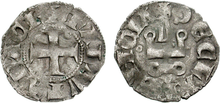
Back Matilda de Eno Azerbaijani Matilda d'Hainaut Catalan Mathilde von Hennegau German Ματθίλδη του Αινώ Greek Matilde de Henao Spanish Mathilde de Hainaut French Matilda od Hainauta Croatian Matilde di Hainaut Italian Mathilde van Henegouwen Dutch Matylda z Hainaut Polish
| Matilda of Hainaut | |
|---|---|
 Denier minted under Matilda | |
| Princess of Achaea | |
| Reign | 5 July 1316 – 1321 |
| Predecessor | Ferdinand of Majorca |
| Successor | John of Gravina |
| Co-regent | Louis of Burgundy (1316) |
| Born | November 1293 |
| Died | 1331 (aged 37–38) Aversa |
| Spouse | |
| House | Avesnes |
| Father | Florent of Hainaut |
| Mother | Isabella of Villehardouin |
Matilda of Hainaut (French: Mathilde de Hainaut; November 1293 – 1331), also known as Maud[2] and Mahaut,[3][4] was Princess of Achaea from 1316 to 1321. She was the only child of Isabella of Villehardouin and Florent of Hainaut, co-rulers of Achaea 1289–1297. After Florent's death in 1297, Isabella continued to rule alone until she remarried to Philip of Savoy in 1300. Per arrangements made with King Charles II of Naples, Isabella was not allowed to marry without his consent and after Philip failed to adequately participate in the king's campaigns against Epirus, Charles in 1307 revoked their rights to Achaea. Matilda, just fourteen years old, tried to press her claim as their heir but was refused by the bailiff Nicholas III of Saint Omer, who instead chose to wait for orders from Naples. Shortly thereafter, Charles appointed his favorite son, Philip of Taranto as the new Prince of Achaea.
Philip of Taranto spent little time in Greece and appointed as his bailiff Guy II de la Roche, Matilda's husband. Guy did not last long in this position, dying in 1308. Matilda was then betrothed by Philip of Taranto to his eldest son, Charles of Taranto. In 1313, this betrothal was broken off and Matilda was married to Louis of Burgundy as compensation to the House of Burgundy due to Philip of Taranto in the same year having married Catherine of Valois, previously betrothed to Hugh V, Duke of Burgundy. Philip of Taranto also renounced his rulership of Achaea and bestowed the Principality of Achaea on Matilda and Louis. Before they had travelled to their new domain, Achaea was seized in 1315 by the usurper Ferdinand of Majorca. Matilda and Louis landed in Achaea in early 1316 and secured control of the principality after the defeat and death of Ferdinand in the Battle of Manolada. Their co-rule did not last long; Louis died less than a month later, widowing Matilda for the second time.
The new king of Naples, Robert, wished to exploit Matilda's uncertain position to gain the principality back for his family. In 1317, he proposed that Matilda should marry his brother, John of Gravina. Matilda refused as she did not wish to enter into a third political marriage. In 1318, Robert's emissaries abducted the princess and brought her to Naples by force. She was forced to go through a marriage ceremony with John, but she refused to recognize him as her husband. In 1321, Matilda was dragged in front of Pope John XXII who ordered her to obey Robert and marry John, but she still refused. Matilda then confessed that she had secretly married the knight Hugh de la Palisse. No more attempts were made to marry her to John but Robert could now revoke Achaea from her control as she had married without his consent. Robert also fabricated a story that Hugh had made an attempt on his life, and that Matilda was his accomplice, and used this as an excuse to imprison the princess. Matilda spent the rest of her life as a prisoner, first in the Castel dell'Ovo in Naples and then in Aversa, where she died in 1331.
- ^ Miller 1908, pp. 257–258.
- ^ Metcalf 1983, p. 73.
- ^ Baker 2020, p. 785.
- ^ Topping 1975, p. 107.
Cite error: There are <ref group=lower-alpha> tags or {{efn}} templates on this page, but the references will not show without a {{reflist|group=lower-alpha}} template or {{notelist}} template (see the help page).
© MMXXIII Rich X Search. We shall prevail. All rights reserved. Rich X Search